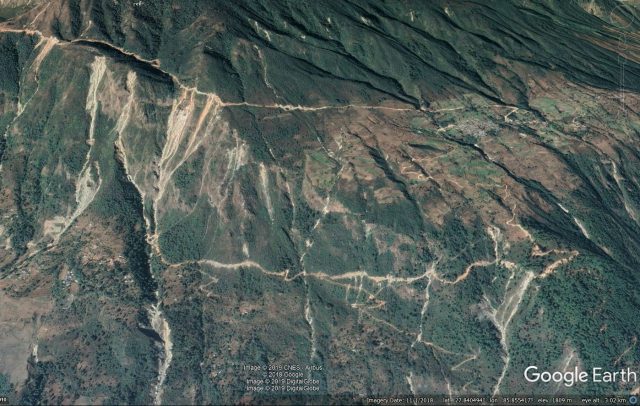1 April 2019
Mountain roads in Nepal
Posted by Dave Petley
Mountain roads in Nepal
One of the major foci in the development of Nepal, as in many poor mountainous countries, has been the construction of mountain roads. The aims are laudable – by providing wheeled connectivity, the roads aim to provide “quicker transportation of goods and better access to employment, education, health care and markets”. But the impacts of roads are complex, with strong evidence that they drive migration and trigger major social changes in the newly connected communities. Not all of these changes are positive.
Whilst I recognise the importance of mountain roads, I have long expressed concerns about the environmental degradation that they cause, using Nepal as a case study. A commentary (Sudmeier-Rieux et al. 2019) has been published in Natural Hazards and Earth System Sciences, which is open access, which examines the issues with mountain road construction in Nepal. The context is the likely convergence between the Chinese Government Belt and Road Initiative and the decentralised approach to development in Nepal, which together are likely to drive the construction of more mountain roads.
Sudmeier-Rieux et al. (2019) note the extraordinary development of roads in Nepal in recent years. In 20 years the local road network (for the most part consisting of mountain roads with minimal engineering, often built by a small team with a bulldozer) has increased by 1200%. In 2011/12, they note that Nepal spent 8% of its national budget on road construction. But, as the authors note, Nepal’s mountain roads “are in a treacherous state, subject to frequent rockfall, landslides and accidents”. The roads lack drainage and slope support, often driving the destruction of irrigation schemes, burying springs and contaminating water supplies, leading to severe losses due to erosion.
The image below shows a typical mountain road in Nepal, illustrating the problem:-

A typical poorly engineered mountain road in Nepal.
.
It is easy to find examples of these impacts of mountain road construction in the Hill Districts of Nepal:-

Google Earth images of the environmental impacts of poorly constructed mountain roads in Nepal.
The authors make a strong argument that the problem is political not technical. The engineering techniques exist to make these mountain roads sustainable. Sudmeier-Rieux et al. (2019) argue that the major problems with these poorly constructed mountain roads can be managed if “government policies were enforced to achieve well-established road engineering designs, including basic standards of road grading, alignment, drainage and bioengineering”. They argue that the move to decentralisation of power in Nepal, and the influence of the Belt and Road Initiative, provides the mechanisms to exert this control.
It is hard to disagree. Sadly, I have little confidence that it will happen, and I fear that we will now see a new wave of road construction driving increased landsliding in Nepal, with high levels of loss and more environmental damage.


 Dave Petley is the Vice-Chancellor of the University of Hull in the United Kingdom. His blog provides commentary and analysis of landslide events occurring worldwide, including the landslides themselves, latest research, and conferences and meetings.
Dave Petley is the Vice-Chancellor of the University of Hull in the United Kingdom. His blog provides commentary and analysis of landslide events occurring worldwide, including the landslides themselves, latest research, and conferences and meetings.
I find this very interesting, not least of which is the fact that many of these issues have plagued developed nations for decades. A prime example is the forestry industry in British Columbia, Canada where roads are constructed in mountainous terrain to access large tracts of timber. For years roads were ‘designed’ and constructed by the drill and blast and earthworks contractors. It goes without saying many roads associated with forest cut blocks led to the same issues referenced in the post above. Many engineering and geoscience consultants have made a career for themselves specializing in the remediation of forest resource roads. To that end, there is a large amount of literature and guidelines that could be used to support the Nepalese in developing best practices for construction of roads mountainous terrain in their country. There just has to be a willingness on both sides – federal and de-centralized governments – to change how things are done.
This article highlights the issues of road construction practices in the Nepal Himalaya. Most of the problems exist in the village road constructions rather than National Highways. An example can be taken from Dharan-Dhankuta road where Bio-engineering measures are extensively applied and considered one of the best roads in Nepal. However, better governance and enhancement of technical capacity with proper engineering geological investigation will improve the condition in future.
Looks like some of the “quick and dirty” 70-80’s vintage logging roads we have had to deal with here in Northern California. Loose sidecast and poor road drainage have been the main drivers of mass wasting like this. Mitigation after failure takes far more resources than good common-sense initial construction. If the builders can be educated in just a few basic concepts (Benched, compacted fills; appropriate road drainage) using equipment they already have, the problem can be reduced greatly.
I would say, the “A typical poorly engineered mountain road in Nepal” even not an engineered road. Based on my experience, most of the mountainous roads are still being developed without any prior engineering design. First, a track has been developed (as shown in first figures) by villagers or local people based on local demand and community decision. Second, they sent a request for approval and then it may or may not be requested for engineering design.
Thanks Dave Petley for your article. I do agree on your statement “government policies were enforced to achieve well-established road engineering designs, including basic standards of road grading, alignment, drainage and bioengineering” to manage mountain roads in Nepal. Beyond that basic road design training need to be provided for local stakeholders who directly get involved in mountain road construction.